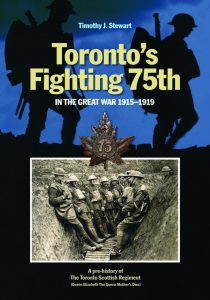On Sunday, June 22, 1953 a liquor store clerk named Bill Beatty died from an accidental fall at his Toronto duplex. Beatty was a plain man who died an ordinary death, yet a Globe & Mail editor pushed his obituary up to page four: “As a result of injuries suffered a week ago in a fall from an upper duplex porch at his home, William James Beatty, 54, of 56 Macdonnell Ave., died yesterday afternoon in St. Joseph’s Hospital. Mr. Beatty, it is believed, suffered a dizzy spell from the heat and lost his balance. He never regained consciousness. A veteran of the First World War, he served overseas with the 75th Regiment.”
He was with the 75th. In a city that celebrated Old School Ties and the exclusivity of private clubs, the combat veterans of the Toronto Scottish Regiment were a privileged class of workers’ aristocracy honoured long after the war’s end.
Author Timothy J. Stewart chronicles their story in Toronto’s Fighting 75th In The Great War, an affectionate account of the city regiment that survived the worst battles of the Western front. Survivors were farmers and stock-jobbers, storekeepers and postal workers. One served a term in the legislature; another was art director at Eaton’s.
Toronto, then and now, was a city of neighbourhoods and tight-knit families. The regiment’s list of dead included ten Browns, five Clarks, four Stewarts and three MacDonalds.
“During the 75ths’ three years overseas, more than 4,000 men had worn its Maple Leaf and Unicorn cap badge; more than 917 had died in battle or afterwards of wounds, or were missing and unknown but to God,” writes Stewart, an educator and curator of the Toronto Scottish museum. “An additional 2,300 had been wounded in body or mind. These were staggering numbers.”
The Fighting 75th is a rich tribute, beautifully illustrated, with vignettes culled from thousands of hours of research. Veterans called the regiment the “six bits.” Their march was “Colonel Bogey,” immortalized later as the theme of Bridge On The River Kwai. They sailed to war on April Fool’s Day to endure “appalling conditions” at the Somme, Vimy and Passchendaele, writes Stewart.
The 75th’s first commanding officer was Samuel Beckett, an architect killed in action at Vimy Ridge as he shouted his last words: “There is no withdrawal; come on again!” Their third commander was Colin Harbottle, an ex-bicycle racer who’d served time in Kingston penitentiary for embezzlement. Harbottle was a zealous reformer in wartime; he fined an infantryman 44 days’ pay for stealing a bottle of cognac. When he died of a heart attack while hunting partridge at Muskoka in 1933 old soldiers lined the streets of Toronto, heads bowed.
Historian Stewart documents their stories with genuine warmth and a police reporter’s eye for detail. The Fighting 75th had one Victoria Cross winner, and seven men court-martialed for self-inflicted wounds. One private, Laurence Ramsay, 21, was killed in action in 1918. A friend found an undated letter in Ramsay’s helmet: “Dear Mother,” it read, “Should I fall in action, I wish to leave you this last farewell…I am as good a boy when I write this as that far off day when I left my beloved home.”
Beautiful.
By Holly Doan
Toronto’s Fighting 75th in the Great War 1915-1919: A Prehistory of The Toronto Scottish Regiment, by Timothy J. Stewart; Wilfrid University Library Press; ISBN 9781-77112-1828; $59.99






